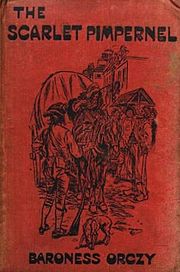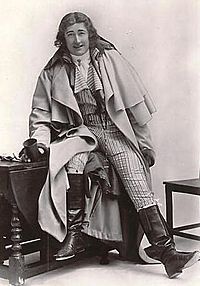The Scarlet Pimpernel

The Scarlet Pimpernel (1934) – Full Movie – Captioned
An English nobleman, the Scarlet Pimpernel, assumes a dual identity to outwit the French Republicans and aid innocent aristocrats during the French Revolution. Based on a novel by Baroness Orczy. Originally released as a theatrical production. (B/W) Public domain film.
The Scarlet Pimpernel is a play and adventure novel by Baroness Emmuska Orczyset during the Reign of Terror following the start of the French Revolution. The title character, Sir Percy Blakeney, represents the original “hero with a secret identity” that inspired subsequent literary creations such as Don Diego de la Vega (El Zorro) and Bruce Wayne (Batman).
Character
 Anagallis arvensis, the Scarlet Pimpernel flower
Anagallis arvensis, the Scarlet Pimpernel flower
Sir Percy is a wealthy English baronet who rescues individuals sentenced to death by the guillotine. He soon reveals himself to be a master of disguise, an imaginative planner, a formidable swordsman and a quick-thinking escape artist. With each rescue he taunts his enemies by leaving behind a card showing a small flower—a scarlet pimpernel. The identity of the Scarlet Pimpernel thus becomes a topic of widespread popular interest and the hero himself becomes the subject of an international manhunt by the French revolutionary authorities. To hide his true identity, Sir Percy presents himself in everyday life as a dim-witted, foppish playboy. His secret is kept by a band of friends known as the League of the Scarlet Pimpernel. The league operates as an undercover team in enacting Sir Percy’s rescue plans.
Events in the original novel are related from the point of view of his wife, Marguerite St. Just.
Baroness Orczy’s general sympathy with aristocrats is evident in her stories, where nobility of birth and nobility of character easily correspond. Even so, her tales present commoners as capable of selfless and heroic actions. Marguerite St. Just and her brother Armand, both commoners who initially help bring about the French Revolution, work closely with Sir Percy as members of the League.
Initial publication
Orczy’s original play, The Scarlet Pimpernel, was produced and adapted by Julia Neilson and Fred Terry. It opened on 15 October 1903 at Nottingham’s Theatre Royal and was not a success. Terry, however, had confidence in the play and, with a rewritten last act, took it to London where it opened at the New Theatre on 5 January 1905. The premier of the London production was enthusiastically received by the audience, but critics considered the play ‘old-fashioned.’ In spite of negative reviews, the play became a popular success, running 122 performances and enjoying numerous revivals. The Scarlet Pimpernel became a favourite of London audiences, playing more than 2,000 performances and becoming one of the most popular shows staged in England to that date.
The novel The Scarlet Pimpernel was published soon after the play opened and was an immediate success. Orczy gained a following of readers in Britain and throughout the world. The popularity of the novel encouraged her to write a number of sequels for her “reckless daredevil” over the next 35 years. The play was performed to great acclaim in France, Italy, Germany and Spain, while the novel was translated into 16 languages. Subsequently, the story has been adapted for television, film, a musical and other media.
The international success of The Scarlet Pimpernel allowed Orczy and her husband to live out their lives in luxury. Over the years, they lived on an estate in Kent, a bustling London home and an opulent villa in Monte Carlo. Orczy wrote in her autobiography,Links in the Chain of Life:
“I have so often been asked the question: “But how did you come to think of The Scarlet Pimpernel?” And my answer has always been: “It was God’s will that I should.” And to you moderns, who perhaps do not believe as I do, I will say, “In the chain of my life, there were so many links, all of which tended towards bringing me to the fulfillment of my destiny.”
Plot
 Fred Terry in The Scarlet Pimpernel, 1905
Fred Terry in The Scarlet Pimpernel, 1905
The Scarlet Pimpernel is set in 1792, during the early stages of the French Revolution. Marguerite St. Just, a beautiful French actress, is the wife of wealthy English fop Sir Percy Blakeney, a baronet. Before their marriage, Marguerite took revenge upon the Marquis de St. Cyr, who had ordered her brother to be beaten for his romantic interest in the Marquis’ daughter, with the unintended consequence of the Marquis and his sons being sent to the guillotine. When Percy found out, he became estranged from his wife. Marguerite, for her part, became disillusioned with Percy’s shallow, dandyish lifestyle.
Meanwhile, the “League of the Scarlet Pimpernel,” a secret society of twenty English aristocrats, “one to command, and nineteen to obey,” is engaged in rescuing their French counterparts from the daily executions (see Reign of Terror). Their leader, the mysterious Scarlet Pimpernel, takes his nickname from the drawing of a small red flower with which he signs his messages. Despite being the talk of London society, only his followers and possibly the Prince of Wales know the Pimpernel’s true identity. Like many others, Marguerite is entranced by the Pimpernel’s daring exploits.
We seek him here, we seek him there,
Those Frenchies seek him everywhere.
Is he in heaven?—Is he in hell?
That demmed, elusive Pimpernel.
At a ball attended by the Blakeneys, a verse by Percy about the “elusive Pimpernel” makes the rounds and amuses the other guests. Meanwhile, Marguerite is blackmailed by the wily new French envoy to England, Citizen Chauvelin. Chauvelin’s agents have stolen a letter incriminating her beloved brother Armand, proving that he is in league with the Pimpernel. Chauvelin offers to trade Armand’s life for her help against the Pimpernel. Contemptuous of her seemingly witless and unloving husband, Marguerite does not go to him for help or advice. Instead, she passes along information which enables Chauvelin to learn the Pimpernel’s true identity.
Later that night, Marguerite finally tells her husband of the terrible danger threatening her brother and pleads for his assistance. Percy promises to save him. After Percy unexpectedly leaves for France, Marguerite discovers to her horror that he is the Pimpernel. He had hidden behind the persona of a dull, slow-witted fop to deceive the world. He had not told Marguerite because of his worry that she might betray him, as she had the Marquis de St. Cyr. Desperate to save her husband, she decides to pursue Percy to France to warn him that Chauvelin knows his identity and his purpose. She persuades Sir Andrew Ffoulkes to accompany her, but because of the tide and the weather, neither they nor Chauvelin can leave immediately.
At Calais, Percy openly approaches Chauvelin in a decrepit inn (the Chat gris), whose owner is in Percy’s pay. Despite Chauvelin’s best efforts, the Englishman manages to escape by offering Chauvelin a pinch of snuff, which turned out to be pure pepper. When Chauvelin took this pinch, he effectively incapacitated himself. Through a bold plan executed right under Chauvelin’s nose, Percy rescues Marguerite’s brother Armand and the Comte de Tournay, the father of a schoolfriend of Marguerite’s. Marguerite pursues Percy right to the very end, resolute that she must either warn him or share his fate. Percy, heavily disguised, is captured by Chauvelin, but he does not recognise him, and he is enabled to escape.
With Marguerite’s love and courage amply proven, Percy’s ardour is rekindled. Safely back on board their schooner, the Day Dream, the happily reconciled couple returns to England. Sir Andrew marries the Count’s daughter, Suzanne.
Sequels
Baroness Orczy wrote numerous sequels, none of which became as famous as The Scarlet Pimpernel. Many of the sequels revolve around French characters whom Sir Percy has met and is attempting to rescue. His followers, such as Lord Tony Dewhurst, Sir Andrew Ffoulkes, Lord Hastings, and Armand St. Just (Marguerite’s brother), also take their turn in major roles.
In addition to the direct sequels about Sir Percy and his league, Orczy’s related books include The Laughing Cavalier (1914) and The First Sir Percy (1921), about an ancestor of the Pimpernel’s; Pimpernel and Rosemary (1924), about a descendant; and The Scarlet Pimpernel Looks at the World (1933), a depiction of the 1930s world from the point of view of Sir Percy.
Some of her non-related Revolutionary-period novels reference the Scarlet Pimpernel or the League, most notably The Bronze Eagle (1915).
Members of the League
The Life and Exploits of the Scarlet Pimpernel, a fictional biography of Percy Blakeney published in 1938, named the nineteen members of the League of the Scarlet Pimpernel.
- The original nine League or founder members who formed the party on 2 August 1792: Sir Andrew Ffoulkes (second in command), Lord Anthony Dewhurst, Lord Edward Hastings, Lord John Bathurst, Lord Stowmarries, Sir Edward Mackenzie, Sir Philip Glynde, Lord Saint Denys, and Sir Richard Galveston.
- Ten members enrolled on January 1793: Sir Jeremiah Wallescourt, Lord Kulmstead, Lord George Fanshawe, Anthony Holte, John Hastings (Lord Edward’s cousin), Lord Everingham, Sir George Vigor, Bart., The Hon. St. John Devinne, Michael Barstow of York, and Armand St. Just (Marguerite’s brother).
- Marguerite, Lady Blakeney, is also named as a member of the League in the book Mam’zelle Guillotine, but it is not known when she was formally enrolled.
http://en.wikipedia.org/wiki/The_Scarlet_Pimpernel


